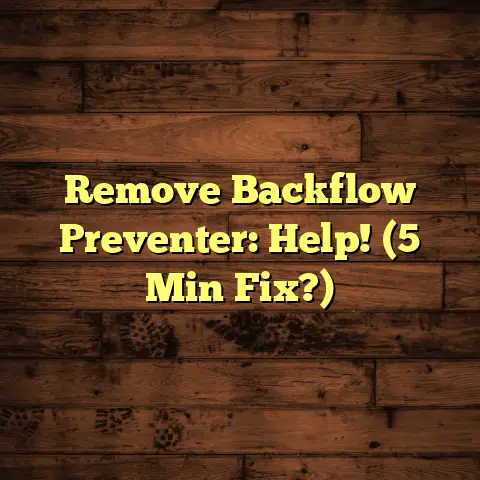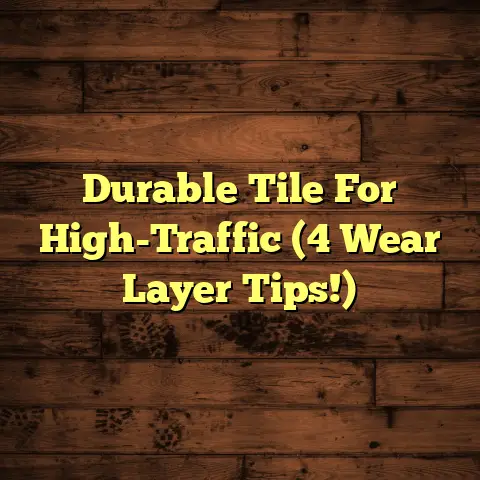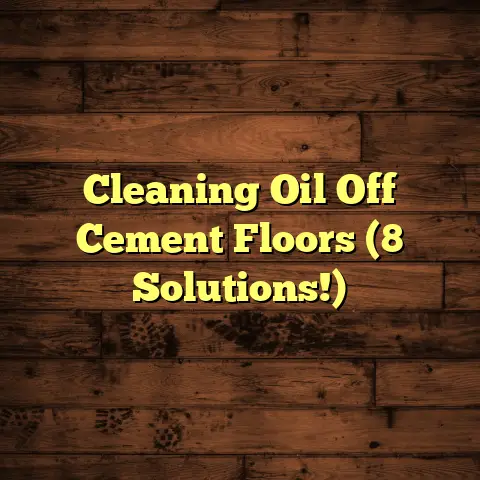Underlayment For Vinyl? (3 Underlayment NO-NOs!)
The Role of Underlayment in Vinyl Installation and 3 Critical NO-NOs
I’m thrilled to chat with you about something that’s often overlooked but absolutely critical in the world of vinyl flooring: underlayment.
The flooring industry is constantly evolving, isn’t it? We’re seeing incredible advancements in vinyl materials, manufacturing, and even the ways we install them.
Think about it: Luxury Vinyl Plank (LVP) and Luxury Vinyl Tile (LVT) are now designed to mimic real hardwood or stone with stunning accuracy!
These advancements have really changed how homeowners and contractors approach flooring projects.
But amidst all the innovation, one thing remains constant: the importance of a solid foundation. That’s where underlayment comes in.
What exactly is underlayment?
Simply put, it’s a layer of material installed between your subfloor and your vinyl flooring.
It acts like a silent partner, enhancing performance, improving longevity, and making your floor feel amazing underfoot.
The right underlayment can significantly improve sound insulation, protect against moisture, and add a layer of comfort you didn’t even know you were missing.
However, here’s the kicker: choosing the wrong underlayment, or skipping crucial steps during installation, can lead to major headaches down the road.
Trust me, I’ve seen it all!
That’s why I’m here to share some insider knowledge. In this article, we’re diving deep into three critical underlayment NO-NOs that can spell disaster for your vinyl flooring project.
Ready to avoid some costly mistakes? Let’s get started!
Section 1:
Understanding Underlayment for Vinyl
Okay, let’s break down the basics.
What is underlayment, really?
Think of it as a cushion or a buffer between your subfloor (the structural base) and your beautiful vinyl flooring.
It’s not just a filler; it’s an active component that plays several vital roles.
There are various types of underlayment available, each with its own set of characteristics and benefits:
-
Foam Underlayment: Typically made from polyethylene or polyurethane. Great for cushioning and sound absorption.
-
Felt Underlayment: Often made from recycled fibers. Provides good insulation and can help smooth out minor subfloor imperfections.
-
Cork Underlayment: A natural and sustainable option. Excellent for sound dampening and insulation.
-
Rubber Underlayment: Offers superior sound and impact absorption. Ideal for areas with heavy foot traffic.
Now, how do you know which type is right for your vinyl flooring?
Well, it depends on several factors, including the type of vinyl you’re using.
Are you installing Luxury Vinyl Planks (LVP), sheet vinyl, or vinyl tile?
Each type has different requirements.
LVP, for example, often benefits from a thicker underlayment to provide extra cushioning and support.
Sheet vinyl, on the other hand, might require a thinner, denser underlayment to ensure a smooth, even surface.
The underlayment also interacts directly with your subfloor, so it’s crucial to consider its condition.
Is your subfloor concrete, plywood, or something else?
Is it perfectly level, or are there bumps and dips?
Underlayment can help mitigate issues like moisture, uneven surfaces, and sound transmission.
For example, if you’re installing vinyl flooring over a concrete slab, you’ll definitely want an underlayment with a built-in moisture barrier to prevent water from seeping up and damaging your floor.
Let’s talk about how these materials are made. Modern underlayment manufacturing has come a long way!
We’re seeing innovations like:
-
Closed-cell foam technology: This makes the underlayment waterproof and resistant to mold and mildew.
-
Recycled content: Many manufacturers are using recycled materials to create eco-friendly underlayment options.
-
Improved sound absorption: New materials and designs are maximizing sound dampening capabilities.
These advancements mean that today’s underlayment is more effective, durable, and environmentally friendly than ever before.
Section 2:
The Importance of Choosing the Right Underlayment
So, why is choosing the right underlayment so important?
Let’s dive into the specific benefits.
First off, thermal insulation.
A good underlayment can help regulate the temperature of your floor, keeping it warmer in the winter and cooler in the summer.
This can translate to significant energy savings over time!
Next up, noise reduction.
If you live in an apartment or have kids running around, you know how important this is!
Underlayment can significantly reduce impact noise (like footsteps) and airborne noise (like voices).
And of course, there’s the moisture barrier protection.
As I mentioned earlier, this is absolutely crucial in areas prone to humidity or spills.
A quality underlayment will prevent moisture from penetrating your vinyl flooring and causing damage.
Now, let’s talk about common mistakes. I’ve seen DIYers and even some professionals make these errors when selecting underlayment:
-
Misconception #1: Thicker is always better. Not necessarily! The ideal thickness depends on the type of vinyl flooring and the condition of your subfloor.
-
Misconception #2: All underlayment is the same. Definitely not true! Different materials have different properties and are suited for different applications.
-
Misconception #3: Skipping underlayment altogether. Big mistake! Underlayment provides essential benefits that can’t be replicated by simply installing vinyl flooring directly on the subfloor.
Investing in the right underlayment is absolutely worth it in the long run.
Let me give you an example.
According to a study by the National Wood Flooring Association (NWFA), using a proper underlayment can extend the life of your flooring by as much as 30%! (Source: NWFA Technical Guidelines)
Think about the cost of replacing your flooring prematurely versus the relatively small investment in quality underlayment.
It’s a no-brainer, right?
I once worked on a project where the homeowner tried to save money by using a cheap, generic underlayment.
Within a year, their vinyl flooring started to buckle and warp due to moisture damage.
The cost of replacing the entire floor far exceeded what they would have spent on a quality underlayment in the first place.
Don’t make the same mistake!
Section 3:
The 3 Underlayment NO-NOs
Alright, let’s get to the heart of the matter.
These are the three critical underlayment NO-NOs that you absolutely must avoid when installing vinyl flooring.
NO-NO #1: Using the Wrong Type of Underlayment
This is a big one.
Using an underlayment that’s not compatible with your vinyl flooring can lead to a whole host of problems.
For example, if you use an underlayment that’s too soft or compressible under LVP, the planks can flex and become unstable.
This can cause the locking mechanisms to fail, leading to gaps and unevenness.
On the other hand, if you use an underlayment that’s too rigid under sheet vinyl, it can telegraph any imperfections in the subfloor, resulting in a bumpy, unattractive surface.
I’ve seen situations where using the wrong underlayment has led to:
-
Mold growth: If the underlayment doesn’t allow for proper airflow, moisture can get trapped and promote mold growth.
-
Warping: Excessive moisture can cause the vinyl flooring to warp and buckle.
-
Poor sound insulation: Using the wrong underlayment can negate any potential sound-dampening benefits.
To avoid this NO-NO, always consult the manufacturer’s recommendations for both your vinyl flooring and your underlayment.
Pay close attention to the recommended thickness, density, and material composition.
If you’re unsure, don’t hesitate to ask a flooring professional for advice.
NO-NO #2: Ignoring Moisture Barriers
This is another critical mistake that can have devastating consequences.
Moisture is the enemy of vinyl flooring.
Excessive moisture can cause the adhesive to fail, leading to bubbling, peeling, and even mold growth.
That’s where moisture barriers come in.
A moisture barrier is a layer of material that prevents moisture from migrating up from the subfloor and damaging your flooring.
In areas prone to humidity or spills, such as bathrooms, kitchens, and basements, moisture barriers are absolutely essential.
Even if your subfloor appears dry, moisture can still be present in the concrete or wood.
According to the Environmental Protection Agency (EPA), indoor humidity levels should be kept between 30% and 50% to prevent mold growth. (Source: EPA Guide to Mold Remediation)
Ignoring moisture considerations can lead to costly repairs down the road.
I’ve seen cases where homeowners have had to completely replace their vinyl flooring due to moisture damage, all because they skipped the moisture barrier.
There are several types of moisture barriers available, including:
-
Polyethylene film: A thin plastic sheet that’s installed between the subfloor and the underlayment.
-
Liquid-applied membranes: A paint-like substance that’s applied directly to the subfloor to create a waterproof barrier.
-
Underlayment with built-in moisture barrier: These combine the benefits of underlayment and moisture protection in one convenient product.
When choosing a moisture barrier, make sure it’s compatible with your vinyl flooring and your subfloor.
Follow the manufacturer’s instructions carefully to ensure proper installation.
NO-NO #3: Skipping the Installation Instructions
This may seem obvious, but you’d be surprised how many people skip reading the installation instructions!
I get it, instructions can be boring.
But trust me, they’re there for a reason.
The manufacturer of your vinyl flooring and underlayment has spent countless hours developing and testing their products.
They know exactly how they should be installed to ensure optimal performance and longevity.
Ignoring their instructions can lead to a variety of problems, such as:
-
Improper seams: If you don’t properly align and seal the seams between the underlayment sections, moisture can seep through and cause damage.
-
Inadequate adhesive use: Using too little adhesive can cause the vinyl flooring to lift and peel.
-
Incorrect underlayment orientation: Some underlayments have a specific orientation that must be followed to ensure proper performance.
I’ve seen countless examples of installation errors that could have been easily avoided by simply reading the instructions.
For instance, I once worked on a project where the installer didn’t bother to read the instructions for the underlayment.
He ended up installing it upside down, which completely negated its moisture barrier properties.
Within a few months, the vinyl flooring started to buckle and peel due to moisture damage.
The cost of redoing the entire floor was significant.
Don’t let this happen to you!
Before you start your vinyl flooring project, take the time to carefully read and understand the installation instructions for both your flooring and your underlayment.
If you have any questions, don’t hesitate to contact the manufacturer or a flooring professional for clarification.
Conclusion
So, there you have it.
We’ve covered a lot of ground in this article, from the basics of underlayment to the three critical NO-NOs that you absolutely must avoid when installing vinyl flooring.
Remember, underlayment is not just an optional add-on; it’s an essential component that plays a vital role in the performance and longevity of your floor.
By understanding the different types of underlayment, choosing the right one for your specific needs, and avoiding the three NO-NOs we’ve discussed, you can ensure that your vinyl flooring project is a success.
As the flooring industry continues to evolve, we’ll undoubtedly see even more innovations in underlayment technology.
New materials, improved designs, and smarter installation techniques will continue to push the boundaries of what’s possible.
But one thing will remain constant: the importance of education and attention to detail.
By staying informed and taking the time to do things right, you can create a beautiful and durable floor that will last for years to come.
Happy flooring!





